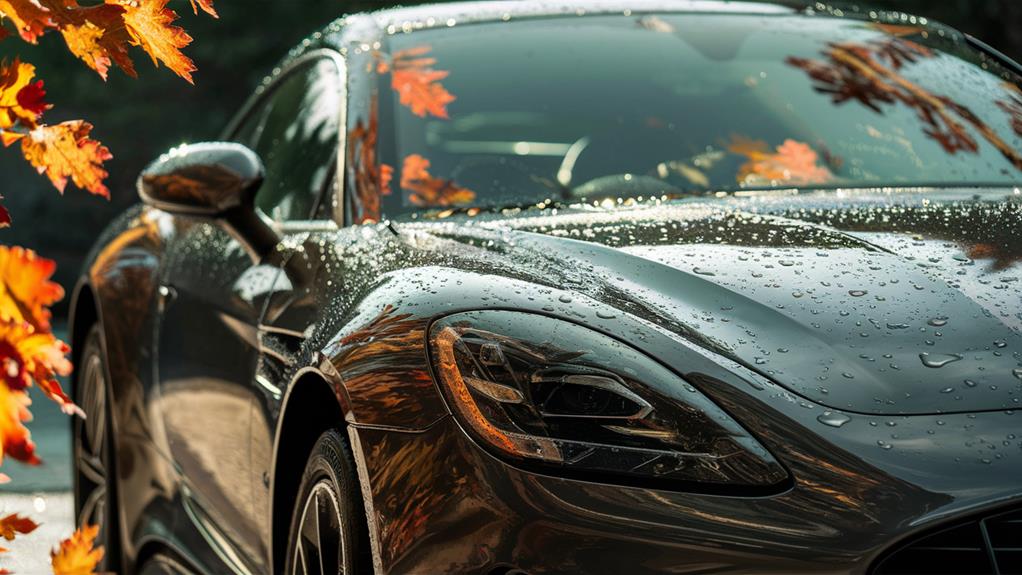Ceramic coating is a liquid polymer that bonds with a vehicle’s paint to provide enhanced protection and aesthetic appeal. It creates a durable layer that guards against UV rays, environmental contaminants, and minor abrasions. This protective coating boasts hydrophobic properties, making surfaces water-repellent and easier to clean, while also delivering a high-gloss finish that amplifies color depth. With a lifespan of three to five years, ceramic coating far outlasts traditional waxes. Proper application and maintenance are crucial for maximizing benefits, and ensuring vehicles look pristine longer. To discover more about its application and care strategies, further insights await.
Key Takeaways

- Ceramic coating forms a strong, molecular bond with your car’s paint, providing long-lasting protection against environmental hazards and minor abrasions.
- The hydrophobic properties of ceramic coating repel water, making cleaning easier and reducing the risk of water spots.
- It enhances the vehicle’s appearance by creating a smooth, glass-like finish that amplifies color depth and maintains a high-gloss look.
- Proper application involves thorough surface preparation and curing time, ensuring optimal bonding and durability of the coating.
- While ceramic coatings require a higher initial investment, their long-term benefits include reduced maintenance costs and improved resale value.
What Is Ceramic Coating?

Ceramic coating is a liquid polymer applied to the exterior surfaces of vehicles, creating a protective layer that bonds with the factory paint. This technology enhances the vehicle’s appearance while providing long-lasting protection against environmental contaminants, UV rays, and minor abrasions. Proper application techniques are crucial for achieving optimal results. Typically, the process involves thorough cleaning, paint correction, and careful application using specialized tools. Technicians often utilize a spray or wipe-on method, ensuring even coverage and promoting strong adhesion.
Cost considerations vary significantly based on several factors, including the vehicle’s size, the condition of the paint, and the specific ceramic coating product used. Professional application generally incurs higher costs due to the skill required and the comprehensive prep work involved. While DIY options exist, they may not offer the same durability or finish quality, leading some car owners to opt for professional services. Ultimately, investing in ceramic coating can enhance a vehicle’s longevity and aesthetic appeal, making it a popular choice for car enthusiasts and everyday drivers alike. Understanding these aspects is essential for anyone considering this advanced protective solution for their vehicle.
How Ceramic Coating Works
Ceramic coating works through a chemical bonding process that creates a strong layer of protection on surfaces. This technology offers hydrophobic properties, allowing water and contaminants to bead and roll off effortlessly. As a result, users benefit from lasting durability, significantly reducing the need for frequent maintenance.
Chemical Bonding Process
The effectiveness of ceramic coatings lies in their unique chemical bonding process, which forms a durable layer that adheres to surfaces at a molecular level. This process begins when the ceramic coating is applied to a vehicle’s paint. The coating contains various bonding agents that interact with the surface’s chemical structure, leading to a highly resilient bond.
As the coating cures, it undergoes a series of chemical reactions. The silicate compounds in the coating react with moisture and heat to create a cross-linked network, enhancing the overall strength and stability of the layer. This bonding is not merely superficial; it penetrates the microscopic pores of the paint, effectively sealing them and providing a robust barrier against environmental contaminants.
The durability of this bond is crucial. It offers protection against UV rays, chemical etching, and physical abrasions, significantly extending the life of the vehicle’s paint. Moreover, the tightly packed molecular structure of the ceramic coating minimizes the likelihood of degradation over time, ensuring that the vehicle maintains its aesthetic appeal. Understanding this chemical bonding process helps car owners appreciate the long-term benefits of ceramic coatings.
Hydrophobic Properties Explained
One of the standout features of a quality ceramic coating is its hydrophobic properties, which significantly enhance the vehicle’s surface performance. These properties stem from the coating’s ability to alter the surface tension of the vehicle’s paint, making it repellent to water. The result is a variety of water-repellency benefits that keep the surface cleaner and reduce the need for frequent washing.
The hydrophobic effect can be illustrated through the following points:
- Easier Cleaning: Water beads up and rolls off the surface, carrying dirt and grime with it, making maintenance less labor-intensive.
- Enhanced Protection: The reduced contact between water and the vehicle’s surface minimizes the risk of water spots and contaminants adhering to the paint.
- Improved Longevity: By repelling water, the ceramic coating helps prevent the degradation of the underlying paint, extending the lifespan of the vehicle’s finish.
Lasting Durability Benefits
Thanks to its unique molecular structure, a quality ceramic coating offers exceptional durability that sets it apart from traditional waxes and sealants. This advanced formulation creates a robust chemical bond with the vehicle’s paint, resulting in a protective layer that withstands various environmental challenges. The durability factors include resistance to UV rays, chemical etching, and physical abrasions, ensuring the coating maintains its integrity over time.
When compared to conventional products, ceramic coatings significantly exceed longevity expectations. While wax may last a few months, a well-applied ceramic coating can endure for several years, often ranging from three to five years or more, depending on the specific product and maintenance practices. This long-lasting protection means car owners can enjoy a consistently glossy finish while minimizing the frequency of reapplication, which saves time and money in the long run.
Moreover, ceramic coatings are less susceptible to wear, enabling them to resist stains and contaminants that would otherwise compromise the vehicle’s appearance. Overall, the lasting durability benefits of ceramic coatings provide car enthusiasts with an effective solution for preserving their vehicle’s aesthetic appeal and enhancing its resale value.
Key Benefits of Ceramic Coating

Ceramic coating offers several key benefits that enhance a vehicle’s appearance and longevity. Its long-lasting protection shields the surface from environmental contaminants, while the enhanced gloss and shine elevate the aesthetic appeal. Additionally, it simplifies the maintenance routine, making cleaning and upkeep more efficient for vehicle owners.
Long-lasting Protection
A key advantage of ceramic coating is its ability to provide long-lasting protection for vehicle surfaces. This advanced technology forms a durable layer that shields cars from various environmental hazards, ensuring that the finish remains intact over time. Vehicle owners can appreciate the following benefits:
- UV Protection: Ceramic coatings resist harmful ultraviolet rays, which can cause fading and oxidation, preserving the vehicle’s original color and integrity.
- Chemical Resistance: The coating protects against harsh chemicals, including road salts and pollutants, minimizing the risk of damage and corrosion that can arise from exposure.
- Hydrophobic Properties: The surface becomes highly hydrophobic, allowing water and contaminants to slide off easily. This reduces the frequency of washes, translating into lower maintenance costs.
While ceramic coatings may require an initial investment, cost considerations often favor long-term savings due to reduced upkeep. Plus, by minimizing the need for frequent washings and harsh cleaning products, ceramic coatings can positively influence environmental impact, making them an eco-friendly option for car care enthusiasts. Overall, the long-lasting protection offered by ceramic coatings significantly enhances vehicle longevity and appearance.
Enhanced Gloss and Shine
One of the standout features of ceramic coatings is their ability to enhance the gloss and shine of a vehicle’s surface. This gloss enhancement is achieved through the application of a liquid polymer that chemically bonds with the paint, creating a smooth, glass-like finish. The result is a reflective surface that not only improves the aesthetic appeal of the vehicle but also amplifies its color depth.
In addition to immediate visual benefits, ceramic coatings also offer shine and longevity. Unlike traditional wax or sealants that wear off quickly, ceramic coatings can last for years, maintaining their high-gloss appearance even in harsh environmental conditions. This durability means that vehicle owners can enjoy a consistently polished look without frequent reapplications.
Moreover, the enhanced gloss and shine provided by ceramic coatings contribute to the vehicle’s overall value. A vehicle that looks well-maintained and visually striking is likely to attract more attention, whether for personal use or resale. In summary, the gloss enhancement and shine longevity of ceramic coatings not only elevate a car’s appearance but also protect and preserve its finish for the long term.
Easier Maintenance Routine
With an easier maintenance routine, vehicle owners can spend less time cleaning and more time enjoying their cars. Ceramic coating significantly reduces the effort required to maintain a vehicle’s appearance, implementing time-saving techniques that streamline the cleaning process. The protective layer formed by the ceramic coating prevents dirt and grime from adhering to the surface, thereby extending the intervals between washes.
Here are three key benefits related to the maintenance routine:
- Reduced Cleaning Frequency: Owners often find they need to wash their vehicles less frequently, as contaminants slide off more easily due to the slick surface of the coating.
- Simplified Cleaning Process: With a ceramic-coated vehicle, the cleaning process becomes straightforward. A simple rinse and gentle wipe can suffice for routine maintenance, eliminating the need for harsh chemicals or extensive scrubbing.
- Enhanced Protection Against Stains: Ceramic coatings offer superior resistance to stains from bird droppings, tree sap, and other environmental factors, further minimizing the need for frequent cleaning.
Comparing Ceramic Coating and Wax
When it comes to protecting vehicle surfaces, ceramic coatings, and waxes offer distinct advantages and drawbacks. Ceramic coatings provide a robust, long-lasting shield against environmental contaminants, UV rays, and scratches, typically lasting several years with proper maintenance. In contrast, waxes, while easier to apply, generally last only a few months before needing reapplication. This significant difference affects the cost comparison; although ceramic coatings have a higher upfront price, their durability can justify the investment over time compared to the recurring costs of waxing.
The application differences between the two products are also noteworthy. Wax can be applied by hand or machine, requiring minimal preparation and allowing for quick touch-ups. Conversely, ceramic coatings often necessitate a more meticulous application process, including surface preparation and curing time, to achieve the desired protective effect. This complexity can be a deterrent for some users but results in a superior finish and protection.
Ultimately, the choice between ceramic coatings and waxes hinges on the owner’s priorities: a higher initial investment for long-term protection or a lower initial cost with more frequent maintenance. Understanding these factors helps vehicle owners make informed decisions regarding their car’s protection.
Application Process Explained

Understanding the differences in application processes between ceramic coatings and waxes can significantly impact the overall effectiveness of the protection. Ceramic coatings require meticulous surface preparation and specialized application tools to ensure optimal bonding and durability.
The application process typically involves three key steps:
- Surface Preparation: Before applying a ceramic coating, the vehicle’s surface must be thoroughly cleaned and decontaminated. This includes washing, claying, and possibly polishing to remove any imperfections. A clean surface ensures better adhesion.
- Application Tools: Using the right application tools is crucial. Applicator pads and microfiber towels are commonly employed to apply the coating evenly. Some products may also require a specific type of applicator to maximize effectiveness.
- Curing Time: After application, the coating needs adequate time to cure. This stage is vital for the coating to bond with the surface, providing long-lasting protection. Curing times can vary based on the product and environmental conditions.
Maintenance Tips for Longevity
Maintaining a ceramic coating is essential for ensuring its longevity and effectiveness. Proper care involves adopting specific cleaning techniques and seasonal care routines. Regular washing is crucial; using a pH-balanced, non-abrasive soap helps preserve the coating’s integrity. A touchless wash is recommended, as it minimizes the risk of scratching the surface.
During the winter months, it’s vital to remove road salt and grime that can compromise the coating. Regular inspections for contaminants like tree sap or bird droppings should be part of the seasonal care regimen, as these can degrade the coating if left unaddressed.
Applying a maintenance spray designed for ceramic coatings can further enhance protection. This step is particularly beneficial after washing, as it replenishes the coating’s hydrophobic properties. Additionally, avoiding automatic car washes with brushes and opting for hand washes will reduce the likelihood of damage.
Common Myths About Ceramic Coating

Many car owners fall prey to common myths about ceramic coatings that can lead to misconceptions about their effectiveness and maintenance. Myth debunking is crucial for understanding the true benefits of these coatings. Here are three prevalent misconceptions:
- Ceramic Coating Makes Cars Scratch-Proof: While ceramic coatings provide a protective layer, they aren’t invincible. They can resist minor scratches but won’t completely eliminate the risk of damage from harsher elements like keying or heavy debris.
- Once Applied, No Maintenance Is Needed: A ceramic coating isn’t a “set it and forget it” solution. Regular washing and proper maintenance are essential to preserve its effectiveness. Neglecting maintenance can diminish the coating’s longevity and performance.
- Ceramic Coating Is Only for New Cars: Many believe that ceramic coatings are only suitable for new vehicles. In reality, they can enhance the appearance and protection of older cars as well, rejuvenating the paintwork and providing a barrier against environmental contaminants.
Understanding these common misconceptions helps car owners make informed decisions about ceramic coatings, ensuring they reap the full benefits of this advanced protection technology.
Is Ceramic Coating Worth It?
Ceramic coating offers significant advantages, but car owners often wonder if the investment is justified. A thorough cost analysis reveals that while the initial application can be higher than traditional wax or sealants, the long-term benefits often outweigh the upfront expense. Ceramic coatings provide superior protection against UV rays, chemical stains, and physical damage, leading to reduced maintenance costs over time.
Customer testimonials frequently highlight the ease of upkeep and the enduring shine that ceramic coatings provide. Many users report that their vehicles remain cleaner for longer periods, reducing the frequency of washes and detailing services. Additionally, the enhanced resale value due to the coating’s protective qualities can further justify the initial investment.
It’s essential for potential buyers to consider their driving habits and the environmental factors their vehicle will face. For those who drive in harsh conditions or want to preserve their car’s appearance, the benefits of ceramic coating become even more apparent. Ultimately, for car enthusiasts and everyday drivers alike, ceramic coating can prove to be a worthwhile investment, delivering both protection and aesthetic enhancement over the lifespan of the vehicle.
Frequently Asked Questions
Can Ceramic Coating Be Applied to Any Type of Vehicle?
Yes, ceramic coating can be applied to various vehicle types. The application process remains consistent across cars, trucks, and motorcycles, ensuring they all benefit from enhanced protection and appearance regardless of their specific design or finish.
How Long Does Ceramic Coating Last Before Needing Reapplication?
When considering longevity, one might say ceramic coatings enjoy a good run, typically lasting two to five years. Durability factors and maintenance tips, however, play crucial roles in extending that lifespan effectively.
Is Ceramic Coating Safe for All Paint Finishes?
He found that ceramic coating’s safety largely depends on paint compatibility and proper surface preparation. If applied correctly, it enhances various finishes, but some delicate paints may require alternative protective solutions to avoid damage.
Does Ceramic Coating Prevent Scratches Completely?
Ceramic coating doesn’t prevent scratches completely, but it significantly enhances scratch resistance and surface durability. It creates a robust layer that helps minimize damage, though care and maintenance remain essential for optimal protection.
Can I Apply Ceramic Coating Myself, or Should I Hire a Professional?
He can apply ceramic coating himself using DIY kits, which provide detailed instructions and necessary application techniques. However, hiring a professional ensures optimal results, especially if he’s unfamiliar with the process or lacks experience.
Conclusion
In conclusion, ceramic coating offers a remarkable fusion of protection and aesthetic enhancement for vehicles. Coincidentally, as car enthusiasts seek long-lasting solutions, this innovative technology emerges as a game changer. By forming a robust barrier against environmental contaminants, it not only preserves a car’s finish but also simplifies maintenance. Ultimately, for those who value their vehicle’s appearance and longevity, investing in ceramic coating proves to be a wise and worthwhile decision.

